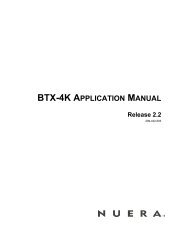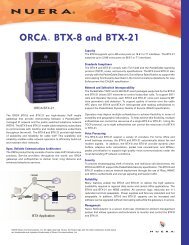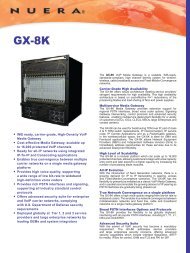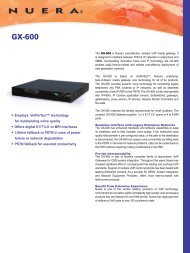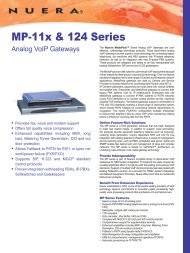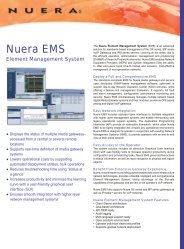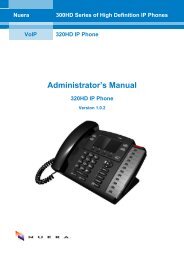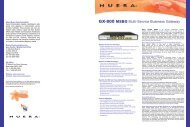GX-3K - Nuera Communications Inc
GX-3K - Nuera Communications Inc
GX-3K - Nuera Communications Inc
Create successful ePaper yourself
Turn your PDF publications into a flip-book with our unique Google optimized e-Paper software.
<strong>GX</strong>-<strong>3K</strong><br />
• Low to mid-density VoIP gateway offering scaling<br />
from 480 to 2016 channels<br />
• Supports high availability configuration with reliable<br />
1+1 redundancy<br />
• Compact footprint (2U), ideal for small locations<br />
• Allows easy capacity upgrades via a software key<br />
• Provides multi-control protocol support: SIP, H.248,<br />
MGCP and TGCP<br />
• Offers broad range of PSTN interfaces including<br />
E1, T1, T3, OC3 and STM-1<br />
• Enables flexible interworking between IP - TDM and<br />
IP - IP<br />
• Supplies a wide range of vocoders which include<br />
Low Bit Rate (LBR), wireline, cellular and wideband<br />
vocoders<br />
• No capacity hit on most of the LBR vocoders<br />
(e.g., G.729, G.723 and AMR)<br />
• Functions as an IMS Media Gateway and I-BGF<br />
network elements<br />
Enterprise<br />
The <strong>GX</strong>-<strong>3K</strong> is a feature-rich, highly available VoIP gateway<br />
supporting low to medium channel densities. The <strong>GX</strong>-<strong>3K</strong> compact<br />
footprint (2U) meets both the needs of service providers with<br />
geographically dispersed networks, as well as those of large<br />
enterprises, where reliable and dense VoIP gateways are necessary<br />
for business-critical communications.<br />
<strong>GX</strong>-<strong>3K</strong> in Service Provider Networks<br />
Service Providers are currently migrating from centralized<br />
legacy TDM networks to decentralized IP networks. The<br />
<strong>GX</strong>-<strong>3K</strong> is aligned with these developments, offering<br />
exceptional channel scalability of up to 2016 DSOs in a compact<br />
19”-2U chassis, allowing it to be placed in small POPs, close to<br />
local telephone networks. Additionally, the <strong>GX</strong>-<strong>3K</strong> delivers<br />
the same carrier-grade availability that service providers are<br />
accustomed to on their legacy equipment. A wide range of<br />
trunking and access protocols to suit any application are<br />
provided, such as PRI, V5.2 and CAS access protocols and<br />
SS7/M2UA/M3UA trunking protocols. The <strong>GX</strong>-<strong>3K</strong> fits the needs of<br />
wireline, cable, cellular and mixed service providers.<br />
<strong>GX</strong>-<strong>3K</strong> in Large Enterprises<br />
The migration to VoIP in the enterprise is driven by cost<br />
considerations and the need for a richer, integrated telephony<br />
service. This transition leads to heterogeneous enterprise<br />
telephony networks that deploy multiple PBXs from various<br />
vendors, some of which are legacy and some of which are<br />
IP-based. An enterprise might choose to connect to a PSTN<br />
Service Provider or to an Internet Telephony Service Provider<br />
(ITSP) or both. The <strong>GX</strong>-<strong>3K</strong> has comprehensive PSTN access<br />
capabilities as well as SIP to SIP interworking features that enable the<br />
interconnection between all these elements. Large enterprises<br />
typically deploy business critical contact centers where the<br />
high availability of the <strong>GX</strong>-<strong>3K</strong> is a key factor. In addition to<br />
E1/T1 interfaces, the <strong>GX</strong>-<strong>3K</strong> supports high-density PSTN<br />
interfaces, such as T3, STM-1 and OC3 to provide the enterprise<br />
with lower PSTN lease costs. The proven interoperability of the<br />
<strong>GX</strong>-<strong>3K</strong> with different PBXs and PSTN switches facilitates smooth<br />
deployment.<br />
Service Provider
<strong>GX</strong>-<strong>3K</strong><br />
Specifications<br />
Media Processing<br />
Capacity<br />
Voice Coders<br />
Echo Cancellation<br />
Fax and Modem<br />
Transport<br />
DTMF/MF<br />
Quality<br />
Enhancement<br />
Signaling<br />
PSTN Access<br />
PSTN Trunking<br />
IP Transport<br />
Up to 2,016 channels in simplex or redundant configuration<br />
High Definition Voice Codecs¹: G.722, G.722.2 (Wideband AMR), G.729.1<br />
(Wideband G.729)<br />
Wireline: G.711, G.722 1 , G.723.1, G.726/7, G.729A/B, EG.711,<br />
MS GSM, iLBC 1<br />
GSM/UMTS: GSM-FR, GSM EFR, AMR, AMR-WB 1<br />
CDMA: EVRC 1 , EVRC-B 1<br />
Independent dynamic vocoder selection per channel (within each group)<br />
Not all coders can be used simultaneously<br />
G.165 and G.168-2002 compliant, with 32, 64 or 128 ms tail length<br />
Fax/Modem Detection Control, T.38 (IP) compliant Group 3 & SG3 fallback to<br />
T.30, fax and modem bypass (automatic fallback to G.711) support<br />
IP-side or PSTN-side detection and generation, RFC 2833 compliant DTMF relay<br />
Detection and Generation of Call Progress tones<br />
VAD, CNG, dynamic programmable jitter buffer, 802.1p/Q VLAN tagging,<br />
DiffServ<br />
E1 ISDN: EuroISDN, QSIG, Australia, Hong Kong (HKT), Korea, New Zealand,<br />
INS-1500 (Japan), VN3, VN4, VN6 (France); T1 ISDN: NI2, 4ESS, 5ESS,<br />
DMS100;E1 CAS: MFC-R2 (multiple variants), MELCAS; T1 CAS: E&M,<br />
GroundStart, LoopStart; V5.2; IUA<br />
SS7/Sigtran: M3UA, M2UA, Redundancy (1+1), SS7 Tunneling<br />
IETF RFC 3550, RFC 3551 RTP/IP Transport, TCP, UDP, RFC3267,<br />
RFC 3558 RTP/UDP/IP, Nb-IP (TS 29.415)<br />
Control Protocols MGCP (RFC 3435), TGCP (PacketCable), MEGACO (H.248, RFC 3015),<br />
SIP (RFC 3261)<br />
IMS Mn - TS 29.332, IMS Mc (TS 29.232)<br />
Security IPSEC, SIP/TLS, HTTPS, SRTP 1 and AES 1<br />
Separation of OAM, Control and Media traffic is possible by using either<br />
different IP interfaces (available only on T1/E1 configuration) or VLANs<br />
SIP IP - IP<br />
SIP - SIP Normalization, Network Topology Hiding, Transcoding and<br />
Mediation³<br />
Conversion, Signaling Translation, Multiple Service Provider Connectivity and<br />
Load Balancing, Redundancy between Servers/Softswitch, Survivability (SAS) 2<br />
Maintenance<br />
Management Element Management System, SNMPv2, SNMPv3, CLI, WEB 3<br />
Maintainability All shelf modules are hot swappable, including boards, power supplies, fans,<br />
and power entry modules<br />
Redundancy Power supply, fans: N+1 load shared<br />
Scheme Media gateway blades (including PSTN interfaces): 1+1<br />
Optical interfaces (PSTN): 1+1, APS protected<br />
Hardware Specifications<br />
Interfaces<br />
PSTN: 1 OC-3 or STM-1 APS optical links, 1 to 3 T3 (DS3) electrical links, up to<br />
63/84 E1/T1 links<br />
IP: Dual Redundant 100/1000 Base-T Ethernet ports and additional two Dual<br />
Redundant 100 Base-T Ethernet ports for OEM and Control (Available on the<br />
E1/T1 configuration only)<br />
Clock Synchronization: BITS/SETS (GR-1244 Stratum-3 and G.813 compliant),<br />
line synchronization (via STM-1/OC-3 link or DS1 trunk)<br />
Enclosure<br />
4-slot, 2U cPCI chassis<br />
Dimensions (HxWxD) 88 mm x 482.6 mm x 296.8 mm<br />
Weight<br />
Approx. 35.27 lb (16 kg), fully loaded<br />
Mounting<br />
Per EIA Standard RS-310-C in 19-inch rack specification<br />
Power<br />
48 V DC Dual Feed, with up to 2 DC Power modules, 100–240 V AC redundant<br />
Dual Feed 2<br />
Cooling<br />
Replaceable fan tray & filter<br />
Regulatory Compliance<br />
Telecommunication FCC part 68, TBR4 and TBR13<br />
Standards<br />
Safety and EMC • UL60950<br />
Standards<br />
• FCC part 15 Class A<br />
• CE Mark (EN55022 Class A, EN60950, EN55024, EN300 386)<br />
Environmental NEBS Level 3: GR-63-Core, GR-1089-Core, Type 1 & 3, ETS300 019<br />
About <strong>Nuera</strong> <strong>Communications</strong><br />
<strong>Nuera</strong> <strong>Communications</strong>, designs, manufactures &<br />
sells packet voice gateways to communication<br />
service providers worldwide. These products<br />
work over any medium (cable, wireless,<br />
copper and fiber). <strong>Nuera</strong>’s ORCA (Open<br />
Reliable <strong>Communications</strong> Architecture) product<br />
portfolio of VoIP gateways, softswitches,<br />
and management systems provide telephony<br />
solutions for cable and DSL networks,<br />
international long distance networks and<br />
enterprise networks. <strong>Nuera</strong> is a leader in the<br />
broadband telephony market.<br />
<strong>Nuera</strong> <strong>Communications</strong> <strong>Inc</strong>.<br />
Asia Pacific / Middle East Office<br />
31 Kaki Bukit Road 3,<br />
Techlink, #06-19<br />
Singapore 417818<br />
Tel: +65-6493-6688<br />
Fax:+65-6299-4925<br />
US Office<br />
27 World’s Fair Drive, Somerset,<br />
New Jersey 08873, USA<br />
Tel: +1-800-966-8372<br />
Fax:+ 1-732-301-9783<br />
Website: www.nuera.com<br />
©2009 <strong>Nuera</strong> <strong>Communications</strong>, <strong>Inc</strong>. All rights reserved. <strong>Nuera</strong>, the<br />
<strong>Nuera</strong> logo and the other trademarks noted above are trademarks<br />
and registered trademarks of <strong>Nuera</strong> <strong>Communications</strong>, <strong>Inc</strong>.<br />
Ref. # LTRM-04003 07/09 Rev. 04<br />
1 Reduced channel capacity 2 Future Release 3 Available on non High Availability configuration



